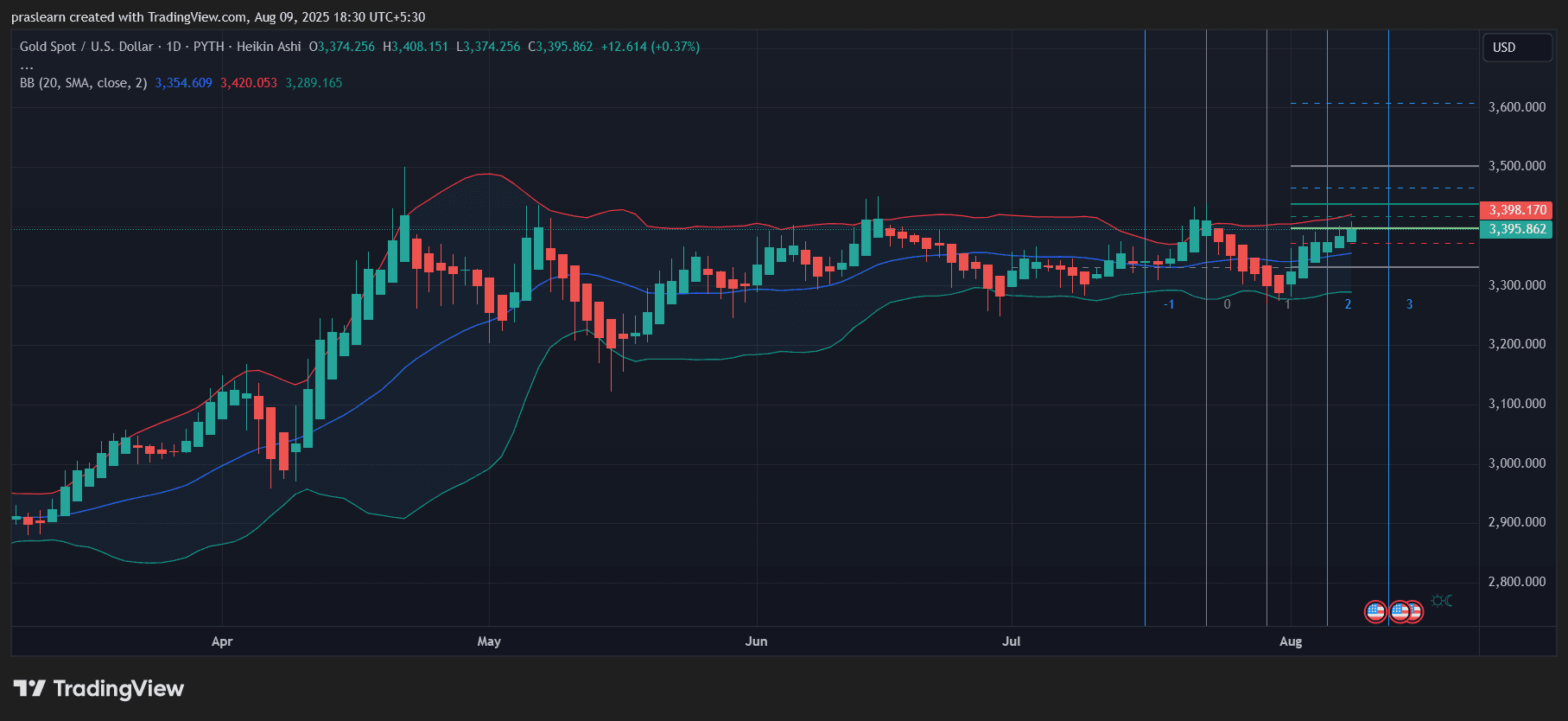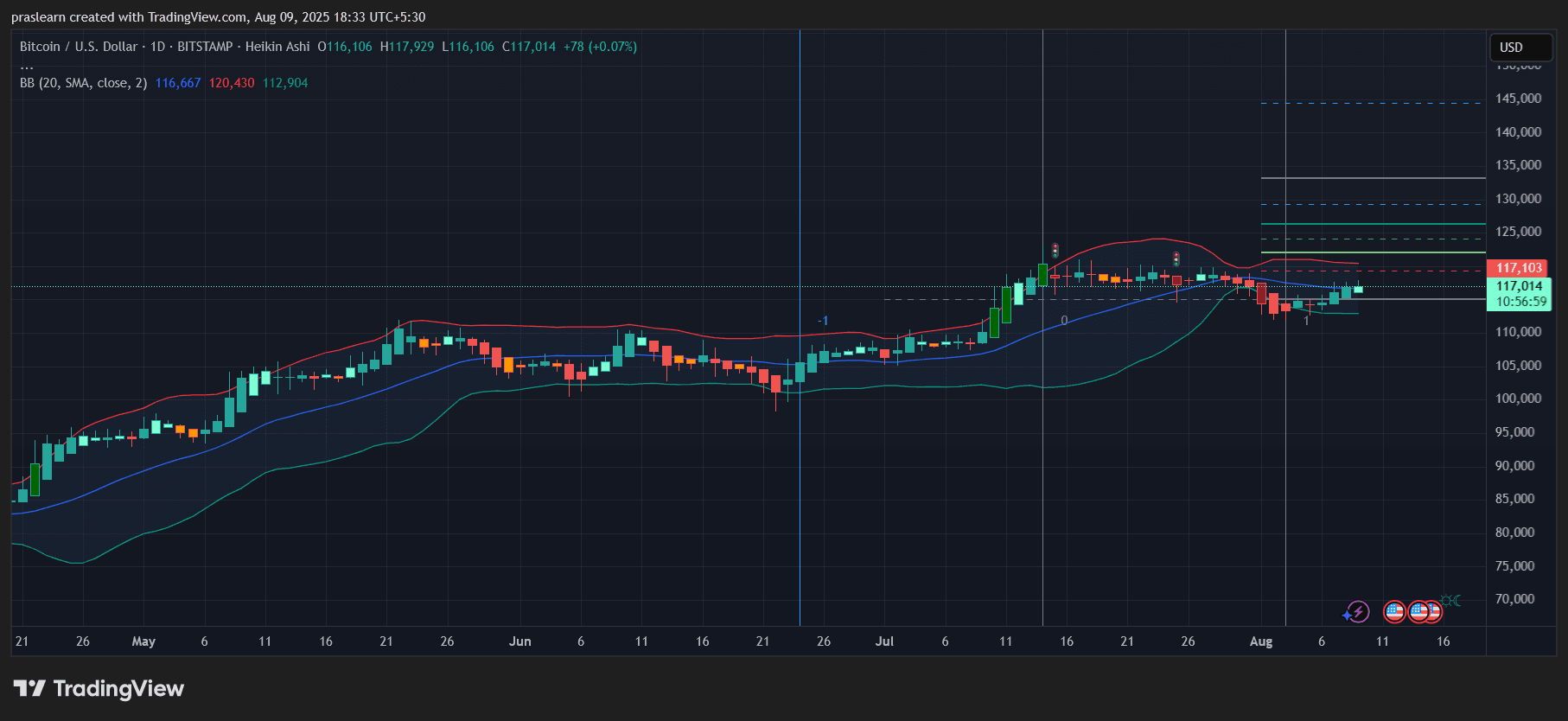Which ETF can make you richer Gold or Bitcoin?
Gold ETFs and Bitcoin ETFs both make hard to hold assets easy to own. One wraps a centuries old store of value. The other packages a new digital asset that moves fast. Here is the thing. They solve different problems, behave very differently, and fit different investors.
Gold ETFs vs Bitcoin ETFs: What problem these ETFs solve?
Both vehicles remove the headaches of custody. You get price exposure inside a regular brokerage account, with simple trading and familiar statements. That convenience comes with fees, tracking quirks, and a layer of fund structure risk that you should understand before you click buy.
How a Gold ETF works?
 XAU/USD Daily Chart- TradingView
XAU/USD Daily Chart- TradingView
A Gold ETF tracks the spot price of gold through holdings at a custodian. You do not own bars in your name. You own fund shares. Expense ratios are usually in the 0.25 to 0.40 range. That looks low, but the meter runs every day. Add brokerage commissions, spreads, and any platform costs and long holding periods can see noticeable drag. Liquidity on major exchanges is strong, yet timing still matters. If you sell into a downdraft you can lock in poor pricing. If a fund ever winds down you may face forced liquidation at an awkward moment. Tracking error is usually small, but it exists, so fund returns can slip a bit versus the metal.
Risks unique to Gold ETFs
Gold ETFs introduce counterparty and structure risk that physical coins do not. The metal sits with custodians and sometimes sub custodians. You are relying on that chain to function as designed. Redemption for bars is out of reach for regular holders. For example a large flagship fund requires around one hundred thousand shares to swap for ten thousand ounces. For most investors that means you can only ever exit by selling shares for cash.
Why people buy Gold ETFs?
Investors often use gold as a hedge against inflation spikes, currency stress, or equity bear markets. The ETF wrapper makes that hedge simple to hold and rebalance. The trade off is the steady expense ratio, possible tracking slippage, and the small but real risks that come with any fund structure.
How a Bitcoin ETF works?
 BTC/USD Daily Chart- TradingView
BTC/USD Daily Chart- TradingView
A Bitcoin ETF holds or tracks Bitcoin and turns it into a brokerage friendly security. You get exposure without wallets, seed phrases, or learning blockchain tools. Fees are higher than gold funds, commonly around 0.75 to 1.25. That reflects the cost of managing crypto market operations and custody. The shares trade on stock exchanges during market hours just like any equity ETF.
What really drives a Bitcoin ETF?
The engine is Bitcoin itself. Price can move hard in both directions on sentiment shifts, liquidity changes, and policy headlines. Small news can produce big swings. The upside is large when capital flows in. The downside is painful when risk appetite dries up. Fund level issues can add noise, including premiums or discounts during fast markets and brief tracking gaps around volatile sessions.
Risks unique to Bitcoin ETFs
Expect higher volatility and sharper drawdowns than almost any traditional asset. Regulatory changes can affect operations, index methodology, or access in certain regions. If market makers step back during stress, spreads can widen and execution gets tricky. None of this requires crypto technical skill from you, but you are still riding a very volatile asset through a financial wrapper.
Fees, tracking error, and all the hidden costs
Gold ETF fees typically look modest, yet they compound. Bitcoin ETF fees are higher and bite faster. Add trading commissions where they still exist, custodial passes that some brokers add, and the spread you pay on each trade. Tracking error for both types can build over years. Fast markets can also push quotes away from net asset value for short bursts, which matters to frequent traders.
Liquidity and accessibility
Both categories trade on major exchanges with healthy daily volume in the bigger funds. That said, not all funds are equal. Use the most liquid tickers when possible. Gold ETF redemptions for metal are not practical for regular holders, so treat shares as price exposure only. Bitcoin ETFs settle in cash like any stock and cannot be redeemed for coins by retail holders, so if you ever want self custody of Bitcoin, a fund is not the path.
Volatility and drawdowns
Gold tends to move in calmer ranges and can grind for months. Bitcoin can rise or fall by double digits in a week. That volatility is not a bug for every investor. Traders and growth seekers prize it. Capital preservation mandates usually avoid it or size it very small. Know which camp you are in before you size a position.
Taxes and reporting
Gold ETF sales trigger capital gains taxes, with exact rates set by your local rules. Bitcoin ETF sales are also taxed, and because swings are larger you can realize gains or losses more frequently. Always check the rules for your jurisdiction and account type. Tax location matters. Holding inside retirement or tax deferred accounts can change the outcome.
Correlation and role in a portfolio
Gold often behaves like a crisis hedge or real asset diversifier. It can help when inflation runs hot or when equities stumble. Bitcoin behaves more like a high beta growth asset tied to liquidity cycles and risk appetite. In a diversified portfolio, gold is usually a stabilizer while Bitcoin is a return amplifier. That framing helps you decide sizing and rebalancing rules.
Who should pick what and when?
Choose a Gold ETF if your priority is wealth preservation, inflation hedging, and low maintenance exposure. Accept the steady fee drag and structure nuances.
Choose a Bitcoin ETF if you want asymmetric upside and can handle rapid swings, headline risk, and higher fees. Position size conservatively and plan for volatility.
Gold ETFs vs Bitcoin ETFs: Clear takeaway
Gold ETFs package a slow and steady hedge with known costs and small structure risks. Bitcoin ETFs package a fast moving asset with higher fees and real volatility that can power returns or punish impatience. Match the tool to your objective, size it to your risk tolerance, and write down your rebalance plan before you buy.
$Bitcoin, $BTC, $BitcoinETF, $GoldETF, $XAU, $XAUETF
Disclaimer: The content of this article solely reflects the author's opinion and does not represent the platform in any capacity. This article is not intended to serve as a reference for making investment decisions.
You may also like
MicroStrategy Nears S&P 500 Entry After 70 Days of Qualification
Trump Family’s Crypto Profits Likely Exceed $1 Billion
Ethereum Could Be on the Verge of a Major Breakout, Analyst Says

Nivex SeaSpark Yacht Gala: Embracing the Future Wave of Socializing and Finance
Nivex held the SeaSpark VIP yacht event in Singapore, partnering with multiple Web3 companies to create a high-end maritime social experience and explore future connections between technology and finance. Summary generated by Mars AI. The accuracy and completeness of this summary are still being iteratively improved by the Mars AI model.

